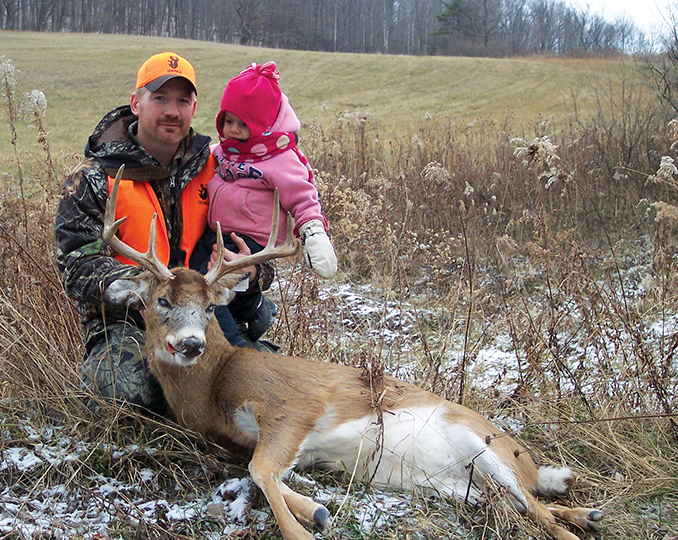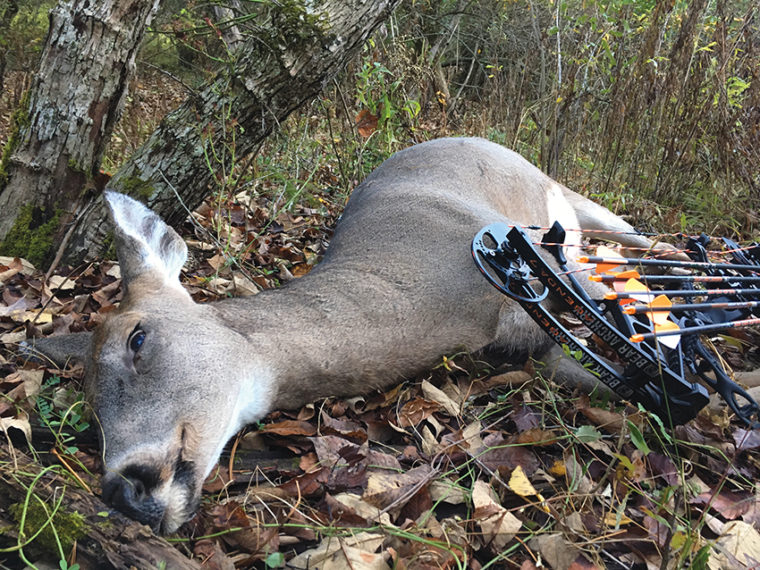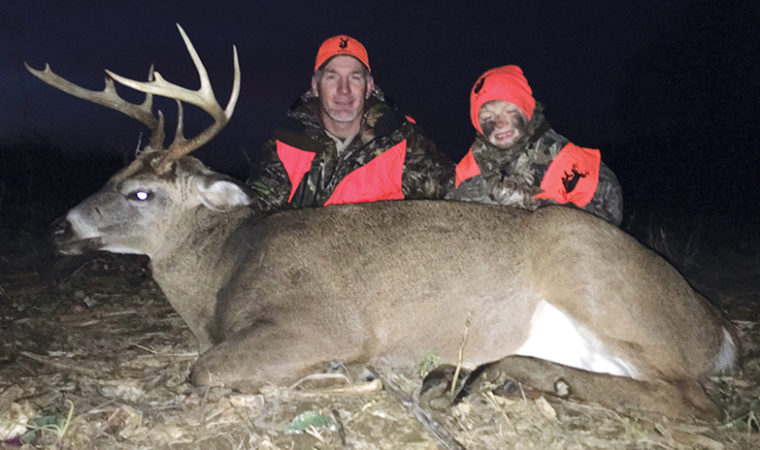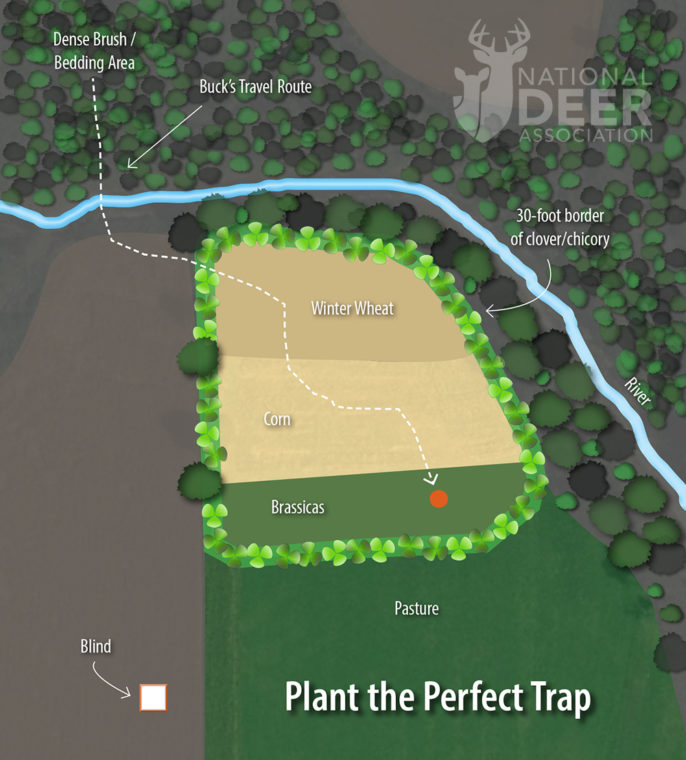Deer hunting is fun. I have been thrilled by the chase since before I was old enough to legally hunt. Four decades ago, mature bucks were nonexistent on our Pennsylvania farm. Mature does were abundant, but we did not know the value of pulling jawbones or learning to estimate age of harvested deer. The situation is very different today. We routinely shoot fully mature bucks and does, and getting them in shooting range is quite different from fooling young deer. I am by no means a master at doing so, but here are the strategies and setups I used to shoot four mature deer in north central Pennsylvania.
Setting the Stage
My family is beyond blessed to own 700 acres of northern hardwood forests dominated by red and white oaks, mixed with cattle pastures, old fields dominated by early successional vegetation, and a variety of food plots. Our land ranges from about 1,200 to 2,100 feet in elevation, and includes springs, seeps, creeks, and ravines. The forests are mostly mature but include a mix of young and middle-aged stands. The old fields provide tremendous food and cover and include a variety of broadleaf plants and a few non-native grasses that we continually attempt to remove. We have transitioned our food plots to mostly include species that are attractive during fall and winter, given our forest and old field management provides the food necessary to carry the deer herd using our farm.
We got settled, and I glassed down the clover alley to the thick cover across the creek. I immediately spotted the body of a big deer half hidden in the vegetation. It was the perfect hiding spot, and one I’m sure he’d used many times.
I own and live on 39 acres that is part of our farm, and three of the four deer I’ll describe were shot on my land. It is a misconception to believe you need to own hundreds or thousands of acres to kill mature deer. I am living proof. However, I have worked hard to develop a relationship with my neighbors, and we have an informal Quality Deer Management (QDM) Cooperative consisting of about 4,000 acres owned by 15 different people. Not all neighbors participate but enough do to make a difference. It started with a single property back in 2002 and has grown to dramatically enhance the hunting opportunities for everyone in the neighborhood. It wasn’t easy, but it was worth the work. You can do the same where you live.
We share our land with numerous family members and friends. About 20 people hunt our farm each year, so our hunter density is higher than most of our neighbors, and the first step to killing mature deer is minimizing the pressure you put on an area. This was one of the hardest lessons for us back in the early 2000s when we started practicing QDM. Once we finally learned we couldn’t hunt mature bucks like we had been hunting young bucks, our photos of mature bucks changed from merely trail-camera pics to ones of us posing with these incredible animals. Ok, let’s get on with it. Here’s how I fooled mature deer No. 1.
Go Deep – Or Not?
I had been taught that the deeper in the woods you go, the better your chances for a big buck. This made sense to me, and I followed this advice for years. I believe this is sage advice in certain areas, but unless you own land approaching the size of John Dutton’s Yellowstone Ranch, deeper on your property is often closer to your neighbors, thus defeating your intentions.
I pulled a 180-degree turn from this strategy and only walked a short distance from camp one Friday afternoon during rifle season. I set up on the steep bank of a creek between some thick cover and a corn field behind my house. This setup may work in archery season, but it had almost no chance for success during rifle season, especially after high hunting pressure all around had been applied for nearly a week. Luckily for me, I tried something different, and it worked for just that reason.
In the highly pressured area I chose a spot between my house and our camp, and I was relatively close to both. This particular deer was an old veteran, and he knew how to avoid hunters by staying close to home – my home. However, he stepped from cover with far too much shooting light remaining, and I sat mesmerized behind a blown-down pine tree on the creek bank. At just beyond bow range, my rifle blast startled my wife, who was in our house.
I’ll bet that 8-point did exactly the same thing countless times before while everyone at camp was deep in the woods. This was the first fully mature buck on our farm, and he cementum-annuli aged at 8½ years old! That would be impressive today, but this happened in 2008 when no one in our Cooperative (me included) would have believed we had a buck of that age running the hills.

This wise buck had learned to avoid the high-pressure areas and live in an unlikely spot that no one thought to hunt, until Kip did. This 8½-year-old buck was proof to local hunters that QDM could work.
Find the Funnel
Deer use the landscape differently throughout the year. Their behavior and movement patterns vary, and a knowledge of terrain and vegetation types can help you predict where deer will be at any point throughout the season.
This hunt occurred on November 6, my single favorite day of the year to hunt. Deer movement was peaking in our area, and I had my climbing treestand high in a red oak adjacent to a big hemlock. The evergreen bows completely concealed me from three sides as I faced a heavily used trail running perpendicular across a saddle between two ridge tops.
I am a firm believer in hunting smart with respect to the wind and thermals, not pressuring deer, and capitalizing on the power of the first sit.
Saddles are well known as great places to hunt whitetails, and this particular trail led directly from a thick forested area across mature, open hardwoods to another area of thick cover at a much lower elevation. I chose this exact spot because while deer prefer to move in cover, there was little to none available between the two heavy pieces I described. Rather than moving randomly between them, deer often choose the most direct route when it’s most secure to do so. In many mature hardwood stands that happens at night.
What made it work on this given day was a young buck chased a hot doe from that cover right after daybreak. She beat feet for the next cover and her quickest route was right under yours truly. At just before noon that day, the tenth different buck went by on the same trail, headed for the same place. My arrow changed his plans, and this 5½-year-old cementum-annuli aged 7-point shares a wall in my office with the buck discussed earlier. This setup worked because I considered time of year, terrain that funneled deer movement, and proximity of thick pieces of cover.
Get Close (to Cover)
Many hunters prefer to sit where they can see a lot of ground. This may be in a mature hardwood forest, open field, or over a food plot. I’m the first to admit I like seeing deer, and there are times when a long vantage point is wise, but killing mature deer more commonly occurs near thick cover.
On this hunt I was in a ladder stand right on the edge of a great bedding area. I was as close as you could get without being inside it. The set up was about 100 yards from a food plot and adjacent to an old field being managed for early successional vegetation. My hope was deer would leave the thick cover an hour or more before dark, feed into the old field which also had good cover, and make their way to the food plot. Young deer follow this path and arrive at the food quickly. Mature deer are slower and arrive at the food plot at or after dark. My set-up was intended to intercept them well before the food plot where I’d see them in abundant light and possibly in a slightly less wary state given their proximity to cover.
One early October evening the plan worked to perfection. With an hour of shooting light remaining, a doe and her fawn emerged from cover and were almost immediately in bow range. Some friends scoffed that I should have waited for a buck. Maybe so, but we needed several adult does to meet our target harvest quota, this deer was clearly an adult doe, and I had my young son Bo in the stand with me. It was a no-brainer. I was taking the shot, and I’m glad I did.
It was the first deer my son and I got together, and the doe cementum-annuli aged at 13½ years! It’s the oldest deer I’ve ever shot, and I strongly consider it one of my most memorable hunting achievements. That doe had likely fooled me and my camp mates on who knows how many hunts, but our set-up right on the edge of cover and far removed from the food plot is what allowed us to put my tag on that prized deer.

Cementum annuli lab analysis of an incisor tooth revealed this doe was 13½ years old! It’s the oldest deer Kip has ever killed and one of his most memorable hunting achievements, and there was a strategy behind the story.
Plant the Perfect Trap
We have beef cattle and rotationally graze them through the 12 acres of pasture behind my house. I like raising cattle, but I love hunting deer, so several years ago I carved out 7 acres at the back of the pasture for food plots. I’ve planted nearly every major food plot species, but I really like the combination of species in the diagram on this page.
All are highly preferred by deer, and the 30-foot ring of clover/chicory provides attraction throughout our archery season. It’s also low enough to provide a great view of deer entering the field from any direction. This is extremely important for viewing deer that want to immediately enter the standing corn. I then break the rest of the food plot up into equal thirds.
I am a huge fan of winter wheat (especially awnless varieties) and winter rye, and I will plant either of them singly or mix them together. They attract deer throughout our archery and firearms seasons, provide food all winter, and are one of the first species to green up in the spring. I am also a big fan of corn, as it provides great cover in addition to attraction throughout our firearms season and deep into winter. For the final third I absolutely require brassicas. They provide an incredible amount of forage per acre, outstanding attraction during archery and firearms seasons, and will stay green all winter, so deer literally can feed on them all the way to spring. They are also one of the least expensive food plot seeds, so they’re budget friendly.
I rotate these crops each year to minimize pest problems, so the exact location of corn varies. It may be at the end of the field closest to the river, at the front of the field closed to my house, or in the middle. For mature deer No. 4, it was in between the others, and that was key to my success.
It was the fifth day of our firearms season, and hunting pressure in our area had been high. As soon as Bo got home from school, we hurried to a popup blind in the field behind our house. Bo wasn’t big enough to shoot a rifle yet, but he never missed the opportunity to be my hunting partner. We got settled, and I glassed down the clover alley to the thick cover across the creek. I immediately spotted the body of a big deer half hidden in the vegetation. It was the perfect hiding spot, and one I’m sure he’d used many times. Fortunately, with just over an hour of shooting light left, he got out of his bed and headed our way. We lost sight as he dropped down into the creek, but he soon emerged in the clover alley and provided a quick broadside view before walking in to the winter wheat behind the corn. I immediately estimated him at 5½ years old and knew he had 9 or 10 points. It was 4:08, and we had exactly 60 minutes of legal shooting time left. Bo and I saw several deer that night feeding in the brassicas, and I had an idea that’s where the buck would end up. The big question was whether he’d make it there before dark.
I said earlier I liked the corn between the wheat and brassicas. That’s because the corn provides a great screen between the road in front of my house and the food plot. If the corn is closest to my house it’s still a great screen, but then I have limited visibility of the wheat and brassicas. If the corn is close to the river, it’s not a screen for either the wheat or brassicas. However, when it’s between them, it can work to perfection.
A last check of my watch showed 4:30 had given way to 5:00 and then 5:06. We wondered if he was behind the corn feeding on wheat or in the corn enjoying a grain supper. Given the other deer had already come through the corn to eat brassicas, I believed that’s what he wanted also, but 5½-year-old bucks don’t make a habit of walking out into open food plots that are within 300 yards of a road – at least not outside of the rut.
My rifle was resting on the shooting sticks, and we were ready if an opportunity presented itself. Then, with literally two minutes of legal hunting remaining, he emerged from the corn. Boom.
We were the happiest two hunters in the Keystone State! The buck weighed 212 pounds, had 21-inch main beams, and cementum-annuli aged at 5½ years (see the photo at the top of this post). We had numerous trail-camera photos of him spanning a few years, but it was the first time I’d ever seen him on the hoof.
This set-up worked because of the corn. He wanted to eat brassicas, and he could do so safely after dark. However, the corn provided the security he needed to get out of his bed at 4:08 rather than 5:08 or later. He wasn’t following a doe. He was solely there to eat, and the corn shielded him from the road and made him feel secure enough that he covered the 300 yards from his bed to emerge 125 yards in front of us with two minutes to go. If the corn wasn’t there I firmly believe there’s absolutely no way he’s standing in that field during shooting hours.
Low Pressure
An additional key to success with all of these setups was minimal pressure, as I shot all four deer on the first or second hunt at those stands. I am a firm believer in hunting smart with respect to the wind and thermals, not pressuring deer, and capitalizing on the power of the first sit.
Modify as Necessary
Regardless of where you chase whitetails, these set-ups can work for you. Your trees, early successional vegetation and preferred food plot species may differ from mine, but the same principles apply. Now is the time to plan next season’s setups. Adapt them to your situation and then enjoy the opportunity to pose in a pic with a mature deer this fall.

